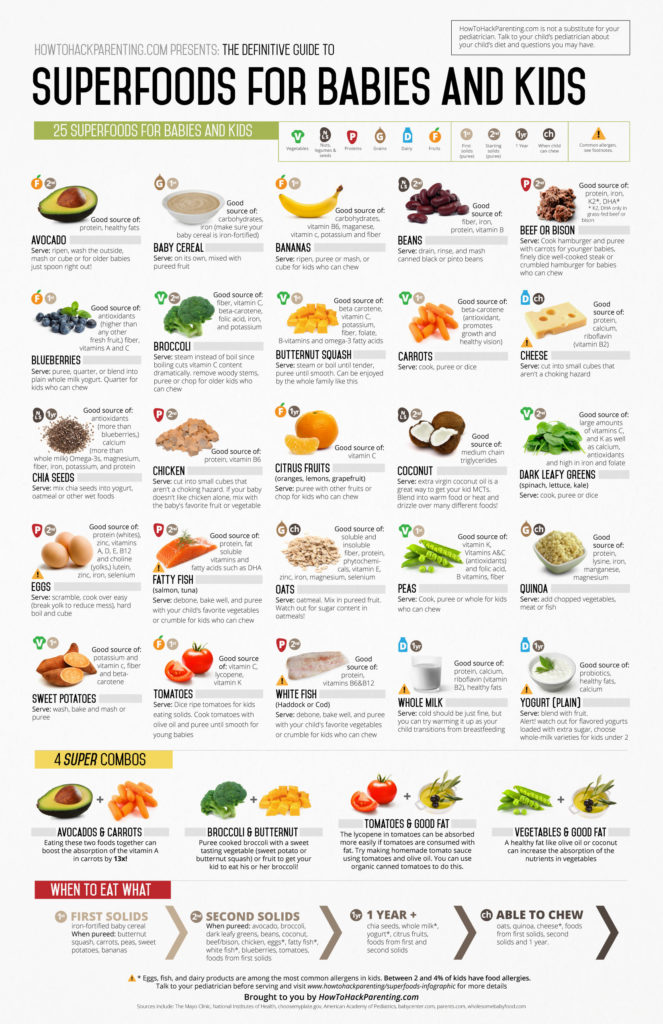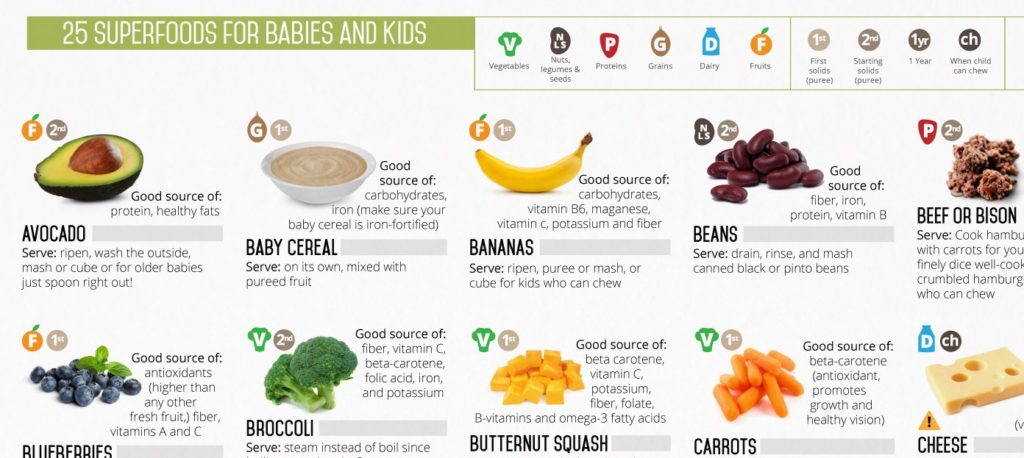The word “superfood” generates a lot of buzz. People in the media throw it around. Companies put it in their ads and on their products to boost sales. Superfoods for babies tends to be even more charged – who wouldn’t want to be feeding their baby or toddler something called a superfood?
So, what’s a superfood? Definitions include, “a nutrient-rich food considered to be especially beneficial for health and well-being” from the Oxford English Dictionary and the Mayo Clinic’s definition of a “great health food”: something that is:
- an “excellent source of fiber, vitamins, minerals and other nutrients”
- “high in phytonutrients and antioxidant compounds, such as vitamins A and E and beta-carotene”
- “may help reduce risk of heart disease and other health conditions”
You’ll note the lack of a standard definition for superfood. Why? The medical community seems to be wary of the term. I see two reasons for this:
- no one “superfood” includes all of the 30-50+ nutrients important to humans. So the concern? By labeling something a “superfood” people will think that’s all they need to eat, as opposed to eating a balanced diet consisting of a variety of healthy foods.
- nutrition is an incredibly complex subject. Our collective understanding of nutrition continues to evolve and change. What’s more, compared to when a food is studied in isolation, its characteristics and benefits may change when it becomes incorporated into a typical diet. So again, labeling something a superfood seems cavalier to academics.
Two valid points. However, the first concern seems a bit overblown: blueberries are good for you, but you shouldn’t only eat blueberries. Most people, I would argue, can figure this out. And the second concern? Hardly seems like a reason to do nothing, or a reason to not try to identify foods that are good for you or your kids.
I would argue there is a set of foods that are generally accepted as being very good for babies who are ready to eat solid food, toddlers, and young kids. (And once you see the list of the best foods for babies, you’ll find they aren’t so different from what older kids or us adults should be eating either.) I’m going to call these superfoods for babies and kids. My working definition will be a food that is one or more of the following things:
- high in nutrients important to the well-being of children (often nutrients otherwise hard to get)
- one of the best ways for your child to get calories from one of the three main energy sources: protein, fat, or carbohydrates
- generally accepted as good for kids
- most certainly better to feed your kid than a bag of chips (unless your kid is allergic to fish and you have to choose between fish and a bag of chips)
So, with that definition in mind, below you’ll find an easy-to-use guide to foods that fit the bill: 25 superfoods for babies, toddlers, and kids. Clearly, you should not only feed your child foods that are listed in the guide – there are many other healthy foods for babies and children. But, selecting foods from the guide with regularity will help your child eat healthily.
All of the foods listed in the guide are fairly “mainstream”, with the possible exceptions of chia seeds and coconut oil. While my research suggests these foods are certainly safe and have serious health benefits, you should be aware they are the most “out there” recommendations in the guide.
How to use the guide
- NOTE THAT FATHERCRAFT IS NOT A SUBSTITUTE FOR YOUR PEDIATRICIAN. PLEASE TALK TO HIM OR HER ABOUT YOUR CHILD’S DIET.
- ALSO, THE SUPERFOODS IN OUR GUIDE INCLUDE SOME FOODS THAT ARE TOP ALLERGENS FOR KIDS. TALK TO YOUR PEDIATRICIAN BEFORE SERVING THESE.
- At the top of the guide, you’ll find a key showing you how to interpret important information about each food: its food group, at what point you can start giving this food to your child, and whether or not the food is a common allergen in kids.
- First solids can be among the first foods your child eats when he or she is ready to transition to solid food. Second solids can be part of the ‘2nd wave’ when your child has gotten more comfortable with solids. Note that all of your child’s first and second solids should be pureed or mashed until your child can chew. Foods in the “1-year” category should not be given to children younger than one year of age without consulting a pediatrician, and foods in the “able to chew” category should not be given until the child is comfortable chewing his or her food before swallowing.
- A note on allergens: some of the foods on the list (eggs, fish, dairy products) are among the most common allergens in kids. Somewhere between 2 and 4 percent of kids have a food allergy. Talk to your pediatrician before serving these foods to your child. These foods are marked with an exclamation point in the guide.
- In the main section of the guide, you’ll find information on each of the foods: its food group, when to serve it, the nutrients that make the food “super”, and suggestions for how to serve it. Foods are listed in alphabetical order.
- Read more on the nutrients in the superfoods by scrolling to the bottom of the post.
- Below the 25 foods are 4 ‘super combos’ – combinations of foods that are even more ‘super’ together.
- Finally, you’ll find a quick reference guide for what foods can be served to children of what age.
A final note before we get started: breastmilk is the original superfood. It contains everything your baby needs to thrive for about the first 6 months of life, and continues to be the key component of your baby’s diet until about one year. Do not feel the need to start feeding your child the superfoods in this guide foods before 6 months. When to start solids is another excellent discussion for you to have with your pediatrician.
So, without further ado, here’s the guide. You can click to enlarge or scroll down to download a high-resolution PDF for free.
(click on the below image to enlarge)

What makes the superfoods super: a guide to the stuff in the superfoods for babies
Antioxidants – repair a portion of the damage to cells caused by free radicals (groups of atoms naturally produced by the body, in the air, and in food). Researchers believe that it is important to get a variety of the antioxidants naturally found in foods. Examples of antioxidants: vitamins A, C, and E, beta-carotene, lutein, lycopene, and selenium.
Beta-carotene – part of a family of pigments called carotenoids that help provide vitamin A to the diet. Beta-carotene is also an antioxidant.
Calcium – the body uses calcium for many things, including building strong bones and teeth and keeping them strong.
Choline – critical for brain health and development and healthy liver function.
DHA (docosahexaenoic acid) – a fatty acid essential for the growth and development of the infant brain, and for maintenance of brain function in children and adults. Getting plenty of DHA in the diet improves learning ability. DHA deficiencies are associated with many problems including learning deficits, ADHD, and cystic fibrosis. You can read more in our post about DHA.
Fiber – a type of carbohydrate that is found in plants. Fiber helps move food through the digestive system and helps kids feel full. Research shows that almost all babies and kids don’t get enough fiber. Soluble and insoluble fiber aid in different parts of the digestion process.
Folate and Folic Acid – interchangeable terms for a B vitamin that helps the body make healthy cells.
Healthy fats (avocados, cheese, whole milk, yogurt) – avocado and organic full-fat dairy contain high amounts of omega 3 fatty acids (see below).
Iron – a mineral needed for many normal body functions. Young children are particularly prone to iron deficiency, which can cause learning and behavior issues.
Lutein – a carotenoid that helps defend the eyes from UV light. Eating foods that contain lutein can help the body replenish the body’s levels of lutein.
Lycopene – a carotenoid and antioxidant that is thought to help protect against cancer and heart disease.
Lysine – is one of 9 essential (meaning the body cannot produce them on its own) amino acids, and is important for tissue growth and repair.
Magnesium – a mineral necessary for more than 300 biochemical reactions in the body. It is important for nerve, muscle, and immune system function.
Manganese – an essential nutrient, meaning the body requires it for proper function. Manganese plays a role in bone growth, skin integrity, blood sugar control, and is an antioxidant.
Medium chain triglycerides (MCTs) have many health benefits including improving nutrient absorption for vitamin E, calcium, and magnesium, and are similar to the fats found in human breast milk. Please note the research to support these findings is not as well established as the research on other nutrients in this guide.
Omega-3 fatty acids – essential for many normal body functions, including building cell membranes in the brain, heart health, reducing inflammation and many more. Our bodies cannot manufacture Omega-3 fatty acids, so we have to obtain them from foods we eat.
Phytochemicals – a large family of compounds produced by plants that affect human health. Members of this family include: flavonoids, carotenoids, beta-carotene, vitamin C, folic acid, and vitamin E. Though research is complex, certain phytochemicals, when consumed as part of whole fruits, vegetables and grains, appear to demonstrate protection against cancer and diseases.
Potassium – a mineral required for normal body function, including to move nutrients and waste into and out of cells, and for nerve and muscle communication.
Probiotics – a type of “good” bacteria that can aid in digestion and protect against harmful bacteria.
Protein – one of the three nutrients (protein, carbohydrates, and fat) used as energy sources by the body. Protein helps build, repair and maintain the tissues in the body. The body converts the protein you make into different specialized proteins with various jobs.
Selenium – an essential element for humans. Helps with DNA replication, and protection against infection, and is an antioxidant.
vitamin A – helps with bone growth, and promotes the health and growth of cells and tissues – particularly hair, nails, and skin. Vitamin A also helps with organ function and vision and immune system function.
vitamin B2 (riboflavin) – helps convert protein, fat, and carbohydrates into energy and allows oxygen to be used by the body.
vitamin B6 – helps the body extract energy from food and is involved in many aspects of metabolism and immune function. In kids, a vitamin B6 deficiency can cause issues central nervous system, circulatory system, and other health issues.
vitamin B12 – required for proper red blood cell formation, as well as DNA synthesis and neurological function.
vitamin C (ascorbic acid) – helps the body make and repair numerous types of tissues including skin, ligaments, and blood vessels make collagen, heal cuts and assists with the absorption of iron from other foods. Vitamin C is also an antioxidant.
vitamin D – helps the body absorb calcium and plays a role in nerve, muscle, and immune systems. A vitamin D deficiency in children can cause rickets. Vitamin D is also thought to help in the prevention of a number of diseases. There are two forms of vitamin D important to humans: D2, which is found in plants, and D3, which is produced by skin with sunlight exposure.
vitamin E – helps with immune system function and metabolic processes. It is also an antioxidant.
vitamin K – works along with calcium to build healthy bones and tissues. It also helps with blood clotting.
vitamin K2 – a form of vitamin K involved in calcium metabolism. Recent studies have suggested getting K2 is important in strengthening bones, brain function, and more, especially because humans don’t efficiently convert vitamin K1 into vitamin K2. Please note this research is not as well established.
Zinc – helps with numerous aspects of cellular metabolism and supports growth and development during childhood.
Sources and Further Reading:
The Children’s Hospital of Wisconsin on kids and food allergies
The National Institutes of Health Medical Encyclopedia
Harvard School of Public Health on Antioxidants
Pharmacological Research on the Health Benefits of DHA







